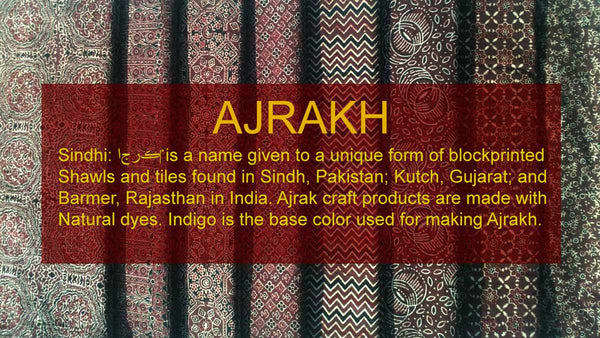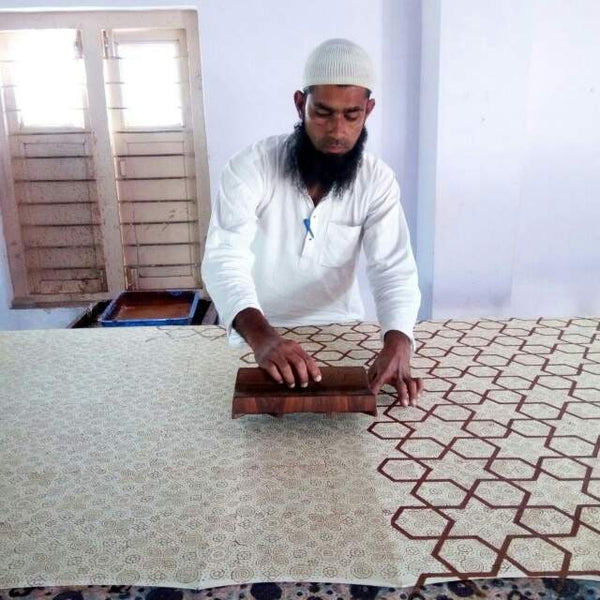
The Khatri Community
In 1630s Raja Bharmal, the kind of Kutch invited members of Khatri community from Sindh to settle and live in the Kutch region for one basic reason - the fabric they printed by hand. The idea was to get these unique prints made exclusively for the royal family, so that no one else had access to those patterns and designs. Eleven generations later, Sufian Khatri runs a small business of handblock prited Ajrakh textiles from the village of Azrakhpur.
In 1630s Raja Bharmal, the kind of Kutch invited members of Khatri community from Sindh to settle and live in the Kutch region for one basic reason - the fabric they printed by hand. The idea was to get these unique prints made exclusively for the royal family, so that no one else had access to those patterns and designs. Eleven generations later, Sufian Khatri runs a small business of handblock prited Ajrakh textiles from the village of Azrakhpur.
Sufian's contribution to the society is great as he employs about 50+ block printing artisans who are expert in Ajrakh fabric printing.

Sufian is just one such entrepreneurs whose family has started this Ajrakh fabric printing business generations ago and now as the technology has progressed, they are making their presence felt around the world. The fabric made by this small community of Khatris is rocking the international fashion world big time.

With help of Indian fashion designers, Ajrakh is touching heights of innovation. Centuries ago, the prints were limited to fabric printing but now these prints are getting replicated on the paper, walls, home decor items, pottery etc while they are being used on fabric as usual.

The Origin Of Ajrakh
Ajrakh is a unique technology of fabric printing which involves about sixteen steps, depending on how many colors and prints are required on one fabric. The word Ajrakh literally means 'Aaj-Rakh' ('Keep it today' in Hindi and Urdu).
Ajrakhpur Village
Most Ajrakh artisans are settled in a village called Dhamadka due to its proximity to the river Saran. The printing process requires lot of water so it is good to have a water source nearby. Water's quality decided the fabric's durability and print quality so the water source should be good and unpolluted.
Most Ajrakh artisans are settled in a village called Dhamadka due to its proximity to the river Saran. The printing process requires lot of water so it is good to have a water source nearby. Water's quality decided the fabric's durability and print quality so the water source should be good and unpolluted.
In 2001, the community saw a measure setback because of the earthquake in the Bhuj area of Gujrat. The quake destroyed the infrastructure and the supplies used in the process. The harm to life was caused. More than 100 members of the Khatri community lost their life.

Leaves, barks of the trees and cow or camel dung to make organic colors for printing. With loss of trees and animals during the earthquake, it became almost impossible to print for a couple of years as establishing new units with proper infrastructure would require money and other resources such as road transport, shops etc.

Later on entire Khatri community came together and found an abandoned land of about 100 acre to start the work. This piece of land was named 'Ajrakhpur'. Some muslim religious organizations came forward to help artisans bring their career on tracks. The community also attracted the international organizations working for the rehabilitation of displaced communities. Some western customers, who were a regular shoppers of the produce Khatri community made, came forward to help and made other fellow workers aware about the situation. The situation improved as the help started pouring in from all corners of the world.

Another printer from Khatri community. Mohammad Ismail Khatri has gained critical acclaim for his innovative use of natural dyes that include a mixture of camel dung, soda ash and castor oil, waste iron, myrobalan, madder, indigo, pomegranate peel boiled in water, sprays of turmeric water and the root of rhubarb.


The Ajrakhpur village is now connected to the main roads of the city with faster means of transportation. Artisans of Ajrakhpur are getting attention from all over the world after fashion and textile designers have initiated movements such as slow fashion. 

People are now more educated about the organic clothing and they are preferring handmade organic clothing over mill made inorganic clothing. All this is easing up the difficulties for the artisans of Ajrakhpur and introducing their talent to the world.



Comments
We r mftr & suppliers of alizarin red B
Mob 9358801614
7017603697